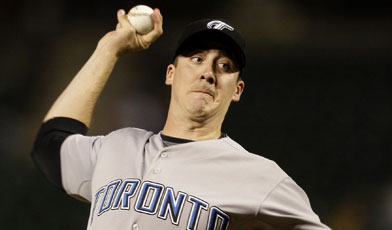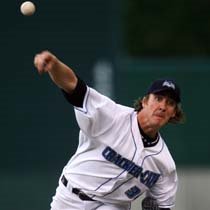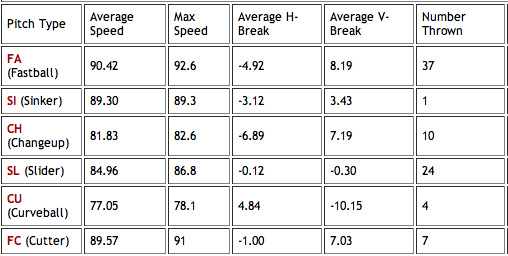The Case for Scott Richmond

The following is a lengthy and well thought out reply to our recent article everyone needs to stop over-rating Scott Richmond. The majority of the text on this page is by ‘Renaissance Man’. I chime in about three quarters of the way through and Renaissance finishes it off.
Renaissance Man
There are so many armchair baseball experts out there, who live and die by stats alone, and this may be a valid way of assessing a position players potential to make it in MLB as he passes thru the minor leagues, but the difficulty in evaluating a pitcher’s potential using only the same criteria, is well known.
It’s often the case, that there are a number of other factors behind the scenes that have an impact on a pitcher’s numerical stats, which if taken into account might give a budding analyst a better read on that pitcher’s real potential.
In the case of Scott Richmond I thought that it might be of use to inform you of some of the background info, which you you and other ‘experts’ are, in all likelihood, blissfully unaware of.
Northern League – Edmonton Cracker Cats 2005-2007

This team finished last in the league 2005,2006 & 2007. As such, Richmond never got to pitch against the worst team in the league. Had he got to do so, more than likely he would have produced more wins during those 3 seasons.
Being the worst team in the league, the relievers recorded more blown saves than any other team and Richmond’s winning stats suffered accordingly. The team batting average was also near or at the very bottom of the league, so Richmond’s stats suffered accordingly from lack of run support.
2005: 4.66 ERA with a 1-4 record
Richmond spent only the 2nd half of the season as a reliever with Edmonton after graduating from Oklahoma State, and was limited to 50 innings.
Not terrible numbers for his 1st half season as a pro, after a full season in college; some fatigue and adjusting to the pro game.
Relievers W & L numbers can be misleading.
2006: 3.03 ERA with a 3-7 record.
Decent numbers considering his supporting cast.
Was selected Pitcher of the Year by the Cats.
2007: 4.26 ERA with a 10-9 record.
His 1st season as a starter. Opened the season with a 1-0 win over previous year’s league champions, going 8+ innings, with 6 or 7 SOs and maybe one BB.
He was selected as the starting pitcher in the Northern League All Star game, with a record of 8-2, and this was achieved while pitching on a 4 man rotation…..only 4 days rest between starts.
In the 2nd half of the season, he pitched on only 3 days rest for 50% of his starts, and the inability to match his 1st half stats was a reflection of the fatigue that he felt…….understandably!
He was selected Pitcher of the Year again by the Cats.
2007 World Cup: 0-2 with a 9.39 ERA
Still fatigued from his Nthrn League season, and his first time with team Canada and International competition. Even though his stats don’t reflect it, since he was brought into games in some really tough situations vs Cuba etc, he really impressed the coaching staff as a rookie, with his ability, toughness under pressure, leadership qualities and gunfighter mentality on the mound.
2008 FOQT: 2-0 with a 1.35 ERA
Here the stats say it quite clearly, but not all of it.
He was the ‘ace’ on the staff for Canada, and team management designed the pitching assignments for the tournament around him matching up with Korea, who went on to win Gold at the Olympics.
This means that he first got to pitch against Mexico where he got the win, and then pitched 4 shutout innings, [the max allowed] against Korea for his 2nd victory.
2008 AA: 5-8 with a 4.92 ERA

As a 28yr old rookie in affiliated ball, after impressing in preseason, he got the ball for the opening day game, ahead of highly touted prospects who’d been with the team for previous seasons. The Fisher Cats found a home in the basement of the Eastern League for almost the entire season, but Richmond was amongst the league leaders in SOs, even though he had a weak supporting cast.
There were also tensions and adjustments to be made coming into this situation so his numbers do not shine as bright as his ability.
2008 AAA: 1-3 with a 3.59 ERA
He was lights out in his 1st few starts, giving up just one run in a shutout loss to Pawtucket, but again the Sky Chiefs were a struggling team headed in the wrong direction. He had one poor outing lasting only 3 innings, which doubled his ERA, and fatigue was likely becoming a factor, having gone more innings than ever before in his career.
2008 MLB: 1-3 with a 4.00 ERA
Once again he finds himself on a struggling Blue Jays team that has a problem scoring runs. He went 5 or more innings in all 5 starts, giving no more than 3 runs per start, 2 of the starts were won by the team, he got credit for one of them.
All 5 starts were quite winnable, even against Cy Young winner Cliff Lee and Dice-K, but the Blue Jay bats were quiet.
Against Boston, had Vernon Wells caught a very catchable fly ball to center, [instead of over running it, and having it bounce off the heel of his glove,] it would have retired the side. Instead the next batter up , David Ortiz onehandedly blooped an opposite field home run just over the wall, allowing 2 runs to score. Had Wells caught that routine fly ball as $127M players are expected to do, Richmond’s ERA would have been 3.33 instead of 4.00 and he would have given up only the one HR in 27 innings, to go along with the 2 BBs.
So there are some of the relatively obscure facts behind the numbers which I trust that you will find at least, interesting.
Matthias (Kman)
Thanks for the in-depth commentary renaissance man.
I do understand what you are saying but at some point a pitcher has to win. At every level it seems like Richmond is caught on a losing team. Other pitcher’s excelled with strong records, era’s, etc during each of his 2008 stops.
When looking at the pitch f/x numbers Richmond has a decent sinking fastball, a pretty flat slider and a straight change (which I do not think complements his sinking fastball). He does not posses any above average pitches. Sept 21st Start vs NYY

I do also see a number of fatigue excuses in each and every poor season/stop in your write-up. At his age I want a pitcher that has built up his arm strength and endurance. He’s not a 19 year old kid who’s just a few years removed from high school.
Renaissance Man
Thanks for taking the time to read my dissertation Kman.
As for above average pitches, Richmond actually considers his
curveball to be his best pitch, and his slider has been described as
quite filthy by more than one commentator, as well as several right
handed batsmen. Kelly Shoppach of the Cleveland Indians who struck out
on it in three consecutive ABs, before breaking his bat over his knee,
might be an insightful interviewee on the subject.

Fatigue was not mentioned an excuse, but an inescapable fact in an
athlete’s life, and a valid reason to be considered when judging a
pitchers talent. Every athlete is subject to the impact of fatigue.
The decline of an athlete’s stats as fatigue becomes an issue is
understood, so the point that I am attempting to make, is that an
athlete’s real time/actual ability, and possibly his potential as
well, might more fairly be judged by his stats when performing when
well or normally rested only, without being tainted by poorer stats
produced when he was obviously fatigued. A perfect example being
Richmond’s 1st half stats in Edmonton in 2007, albeit on a depleted 4
man rotation, compared to his 2nd half stats where 50% of his outings
were on only 3 days rest . Over the years, pitching starters on 3 days
rest in pennant races or the World Series has with few exceptions,
proved to be a disastrous gamble. At least one Blue Jay pitcher hit
the wall at 150 innings last season, and his effectiveness plummeted
subsequently; the official line claiming some occult injury.
Of course it is the responsibility of every pitcher to prepare himself
to maximize his stamina and durability, and to attempt to deliver his
best performances with the minimum effort possible, thereby extending
the number of innings in which he is able to enjoy maximum
effectiveness, but nevertheless, few human beings are likely to be
blessed with the legendary durability showcased by Dice-K in his
pre-Red Sox days.
There remains quite a learning curve within the pitching fraternity on
the issues raised, so the ability to achieve these goals varies
tremendously, much like the shelf life of an MLB starting pitcher.”



Great article gents, very in depth and a good balance to the “Everyone is over-rating Scott Richmond” post. Richmond’s win-loss record really doesn’t tell a clear story about how well he has pitched thus far in the majors and minors. I think I appreciate him even more now …